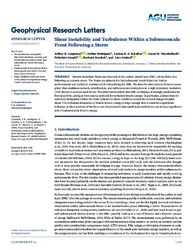Shear Instability and Turbulence Within a Submesoscale Front Following a Storm
Rodrigues, Arthur
Merckelbach, Lucas M.
Baschek, Burkard
Carpenter, Jeffrey R.; Rodrigues, Arthur; Schultze, Larissa K. P.; Merckelbach, Lucas M.; Suzuki, Nobuhiro; Baschek, Burkard; Umlauf, Lars, 2020: Shear Instability and Turbulence Within a Submesoscale Front Following a Storm. In: Geophysical Research Letters, Band 47, 23, DOI: 10.23689/fidgeo-4064.
 |
Dokument öffnen: |
Narrow baroclinic fronts are observed in the surface mixed layer (SML) of the Baltic Sea following an autumn storm. The fronts are subjected to hydrodynamic instabilities that lead to submesoscale and turbulent motions while restratifying the SML. We describe observations from an ocean glider that combines currents, stratification, and turbulence microstructure in a high horizontal resolution (150–300 m) to analyze such fronts. The observations show that SML turbulence is strongly modulated by frontal activity, acting as both source and sink for turbulent kinetic energy. In particular, a direct route to turbulent dissipation within the front is linked to shear instability caused by elevated nongeostrophic shear. The turbulent dissipation of frontal kinetic energy is large enough that it could be a significant influence in the evolution of the front and demonstrates that small‐scale turbulence can act as a significant sink of submesoscale kinetic energy. Key Points:
An autonomous ocean glider observed turbulence, currents, and stratification in surface mixed layer submesoscale fronts following a storm.
Submesoscale fronts provide both a damping and generation of surface mixed layer turbulence.
Shear instability within the front could represent a significant energy transfer in frontal evolution.
Statistik:
ZugriffsstatistikSammlung:
This is an open access article under the terms of the Creative Commons Attribution‐NonCommercial License, which permits use, distribution and reproduction in any medium, provided the original work is properly cited and is not used for commercial purposes.

